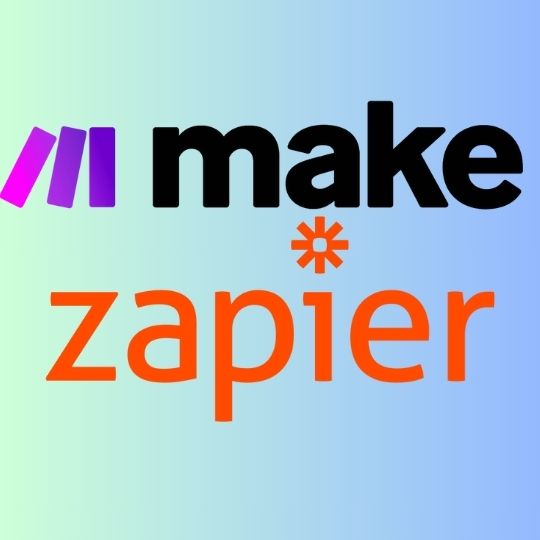In today’s fast-paced digital world, automation is no longer a luxury—it’s a necessity. Businesses, large and small, are constantly seeking ways to streamline operations, cut down on repetitive tasks, and free up their teams for more impactful work. While there are different automations platforms, such as Make.com and Zapier, this article will focus on Make.com. It a powerful and intuitive automation platform that empowers teams to visually build complex workflows without writing a single line of code.
Whether you’re a solo entrepreneur juggling multiple tools, or an agency trying to scale and automate processes efficiently, Make.com offers a dynamic solution to automate almost anything online.
What Is Make.com?
Make.com is a no-code visual automation builder that allows users to create, connect, and automate workflows between thousands of popular apps and services. Formerly known as Integromat, Make.com has rapidly evolved into a top-tier automation platform. Other platforms such as Zapier.
At its core, Make.com helps businesses replace manual, repetitive processes with smart, automated systems that run in the background—saving time, reducing errors, and increasing consistency.
Why Make.com? Benefits That Matter
1. Visual Interface for All Skill Levels
One of Make’s most impressive features is its drag-and-drop visual interface. Instead of overwhelming users with technical jargon or complex configuration steps, Make presents each workflow as a flowchart. This makes it easy to understand, edit, and scale even the most intricate automations. Whether you’re a tech-savvy operations manager or a creative marketer, you’ll find the learning curve refreshingly short.
2. Thousands of Integrations
Make.com integrates with over 1,500 apps, including Google Workspace, Airtable, Slack, HubSpot, Notion, Shopify, Stripe, Gmail, and more. And if a particular tool isn’t directly supported, you can often connect it through Make’s HTTP module or webhooks, effectively expanding your automation potential even further.
3. Save Time (and Sanity)
Automating repetitive tasks can save you hours every week. Whether it’s syncing leads between your CRM and email platform, sending notifications to your team, or updating databases – Make handles it all in real time. That’s more time for you to focus on strategy, growth, and innovation.
4. Affordable Pricing and Scalability
Make.com offers generous free and affordable paid plans that scale with your usage. This makes it accessible for freelancers, startups, and large enterprises alike. You only pay for the operations you use, so it’s cost-effective and flexible.
What Can You Automate With Make.com?
Here’s a glimpse of what’s possible:
- CRM Management: Automatically create or update leads in your CRM (like HubSpot or Pipedrive) from form submissions or emails.
- E-commerce Syncing: Connect your Shopify store with accounting software to log transactions, create invoices, or manage inventory.
- Marketing Automation: Schedule social media posts, trigger email campaigns, and track performance from various sources.
- Project Management: Update task boards (like Trello, ClickUp, or Asana) based on events, deadlines, or team member actions.
- Client Onboarding: Automatically generate and send welcome emails, contracts, and Slack invites when a new client signs a proposal.
The possibilities are nearly endless – if you can map it, you can likely automate it.
Real-World Use Cases (Mini Case Studies)
1. Real Estate Agency
A real estate agency used Make.com to automate their lead management process. When a user submitted a form on the agency’s website, Make automatically added them to a CRM, sent a personalized email with property listings, and notified an agent in Slack. What used to take 30–60 minutes manually now happens instantly – without any human intervention.
2. E-commerce Store Owner
An online store owner wanted to track abandoned carts and follow up with emails. Using Make.com, they built a workflow that listens for uncompleted checkouts, waits 2 hours, and then sends a personalized reminder email with a discount code. This automation recovered 15% more sales within the first month.
3. HR & Onboarding
A digital agency implemented Make to handle internal onboarding. When a new hire was added to an Airtable database, Make triggered a series of events: creating Google Workspace accounts, adding them to Notion docs, and scheduling a welcome message in Slack – all within minutes.
A Simple Automation You Can Build in 5 Minutes
Let’s walk through a basic 3-step automation to give you a feel for how Make.com works:
Scenario: Send an automatic Slack message when a new row is added in a Google Sheet (e.g., a lead or meeting signup).
Step 1: Trigger Module – Google Sheets
- Choose Google Sheets as the trigger.
- Set it to monitor a specific sheet for “New row”.
Step 2: Action Module – Slack
- Choose Slack as the next app.
- Set the action to “Send a message to a channel”.
- Customize the message using dynamic data from the Google Sheet row (e.g., name, email, service requested).
Step 3: Test and Schedule
- Run the automation once to test it.
- Turn on scheduling (e.g., run every 5 minutes).
- Done!
Now, every time a row is added, your team gets notified instantly in Slack. It’s that easy—and scalable.
Why This Should Excite You
Automation platforms aren’t just a utility—it’s a gateway to unlocking time, consistency, and control over your operations. It brings structure and visibility to your workflows without needing a developer or a tech team. In an era where automation defines competitive advantage, platforms such as Make.com or Zapier help you stay ahead.
From marketing to sales, operations to HR, automations empower businesses to build smart systems that scale—visually, powerfully, and affordably.
Final Thoughts
Whether you’re an agency, a solo entrepreneur, or a multi-team organization, automating with Make.com or Zapier is one of the smartest investments you can make in your workflow infrastructure.
It helps eliminate bottlenecks, reduce manual work, and supercharge productivity – freeing you up to focus on what really matters: growing your business. And with how fast the world is changing – this soon will be not only beneficial, but also necessary.

